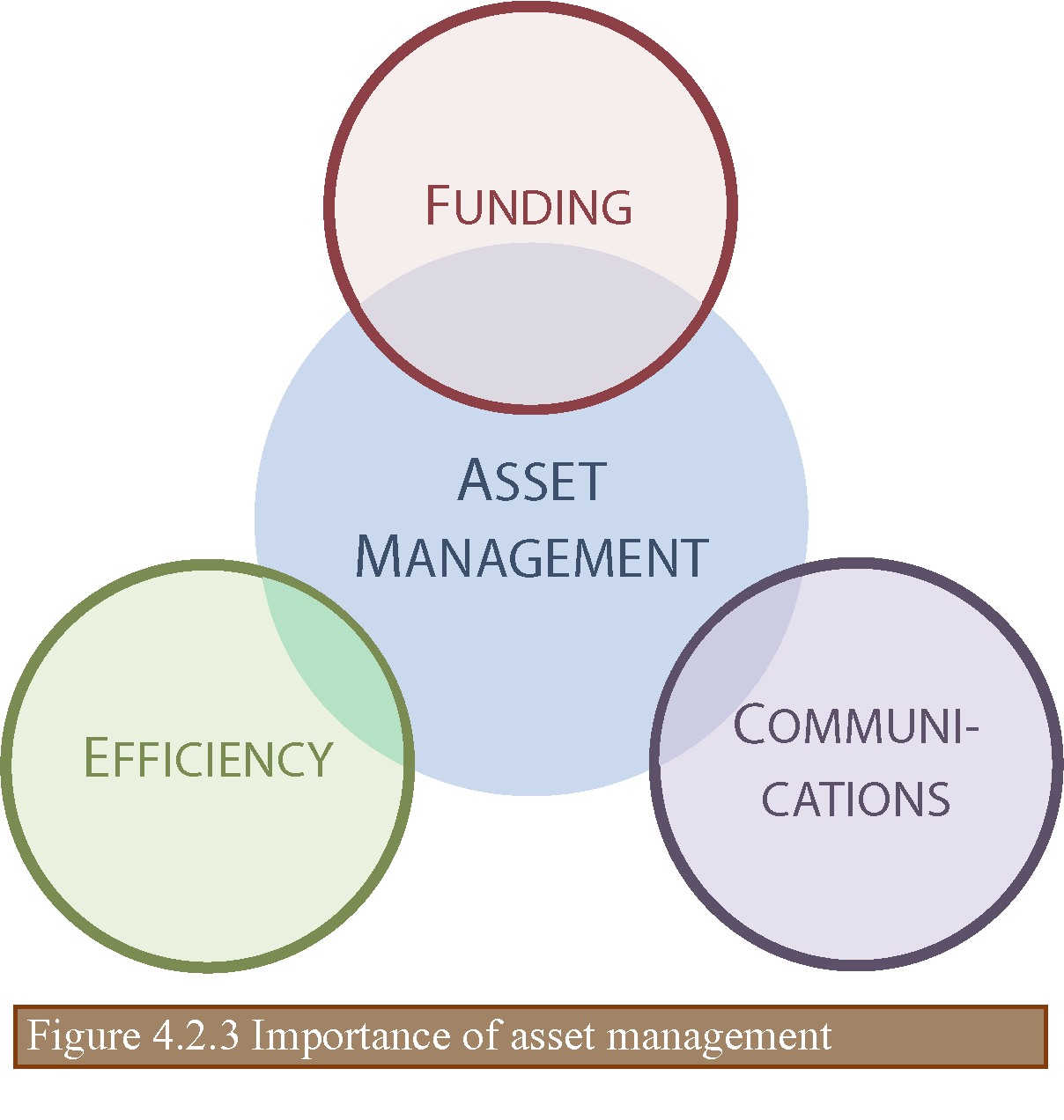

As an organization implements an asset management program, it should develop a communication plan. Augmenting the implementation of asset management with a communication plan can be helpful. Because of the large number of staff and functions that need to be coordinated, communications is essential internally. It is important for staff to understand what is taking place and their roles. Communication with external stakeholders and customers is equally important to convey what is being done, why it is being done, what is planned, and what are the key expectations with regard to level of service, performance targets, and funding scenarios.
Relevant information associated with asset management should be actively communicated through engagement with internal staff and external stakeholders in setting requirements, making decisions, and reporting performance. It is important to discuss and develop a strategy for how this information is communicated, e.g. with pre-prepared material such as videos or annual reports (FHWA, 2017; Swedish Transport Administration, 2016).
Asset management requires high-level and abstract attributes such as long-term vision and strategic goals. It involves detailed information such as the fields of data used for asset inventory and condition databases. To carry out the AMP, road organization employees (Iowa DOT, 2014, Transport asset management) and vendors must understand not only the long-term vision but also the detailed technical requirements of providing the data, conducting the asset assessments, programming the correct projects, and conducting the proper maintenance to achieve the long-term vision. A communication plan and effort can serve an important coordination function. This effort can provide motivation, note accomplishments, maintain momentum, and enhance the breadth, depth, and effectiveness of implementation in the organization.
The personal involvement of the leader can be an important component of the communication effort. Effective communication includes both formal and informal communication, with the informal communication often being the most effective since information is transferred and conveyed in a more freely and quicker way. When employees see the personal engagement of the leader in the asset management implementation effort, it reinforces the importance of and communicates the commitment of the leadership to asset management. It is essential that staff understand that they have a role and what their respective responsibilities are with regard to moving asset management efforts forward.
An external communication plan helps keep the external stakeholders informed, involved (Iowa DOT, 2014, Thinking differently), and supportive of the agency’s asset management effort. Communicating the progress made and the next steps being pursued in the implementation of asset management also shows accountability and adds credibility to the agency’s effort. It is important to have performance measures and targets that are understood.
Engaging with stakeholders to understand their needs and expectations provides the information needed to determine and review the service provided by road infrastructure assets and hence the asset management activities. The road network is often of significant interest to the public and the media. This interest is likely to continue with robust public expectations for how the network should function.
The levels of service that underpin the AMP must be based upon a good understanding of stakeholder and customer priorities and expectations (Austroads, 2009), and they are essential to the success of the AMP. The AMP is an effective mechanism to communicate levels of standards, performance targets, funding scenarios, and outcomes and to manage customer expectations.
An AMP is an important tool in addressing the trend towards transparency, which results in the increased availability of a wide range of information in the public domain. Organizations should provide clarity and transparency in how they make decisions in the identification, assessment, programming, and delivery of asset management activities, including maintenance works, and should clearly explain how such decisions were affected by public input or how these decisions will impact the public.
Providing good quality information to stakeholders on what can be expected from the asset management approach is an important aspect of service to the public. A clear and effective approach to communications within the asset management framework can be an excellent means of providing information and responding to challenges related to programs of maintenance works and value for money (FHWA, 2015). Effective communications also assist with the often high volume of public requests, reports from multiple sources, and media interest in road maintenance. The potholes review undertaken by the Department for Transport in England (HMEP, 2012) and Scotland’s National Road Maintenance Review (Transport Scotland, n.d.) recognize the importance of communications and make recommendations in this regard.
For organizations just initiating an asset management framework, it is common to operate in silos. Efforts need to be in place to establish clear agency goals as well as an asset management group that focuses on how to implement asset management in the organization.
Organizations that are more mature in implementing asset management address one of the key challenges: the introduction of a holistic approach to the delivery of services that removes organizational silos and promotes integration of processes, information, and systems. Introducing this holistic approach leads to a more efficient way of working by removing duplicate and redundant processes and by service-wide decision-making, but it also requires changes to the working culture to engender greater cooperation and flexibility among staff.
To ensure the successful adoption of asset management, the asset management group needs to be proactive in informing other staff and also involve others in the process. The asset management group is established to produce, manage, or steer the development of the AMP and to steer or manage implementation.
The leader of the group conveys the goals and the importance of implementing an asset management framework in the organization. Senior management needs to be involved at key points, needs to fully support the process, and needs to be keen to see the benefits that will be realized.
A program of training and education in good asset management practices needs to be established. This includes allowing staff to be available for training and education in asset and infrastructure management as part of their professional development, and seminars to inform a wider range of participants, including interested external parties, about asset management and about the organization’s progress and intentions.
It is intended that the AMP, as it develops, will be a key reference document to all of those involved in management of service delivery on the road network. The AMP needs to be available internally and externally.
Asset management enables the following (as illustrated conceptually in Figure 4.2.3):

FHWA. 2017. Asset Management. Videos. Available from: https://www.fhwa.dot.gov/asset/video/index.cfm [7 February 2017].
The Swedish Transport Administration, 2016.Annual Report 2015. Available from: https://trafikverket.ineko.se/Files/en-US/17478/Ineko.Product.RelatedFiles/2016_054_trafikverkets_arsredovisning_2016_engelsk.pdf [7 February 2017].
Iowa DOT. 2014. Transport asset management – how does it impact employees? Available from: http://www.transportationmatters.iowadot.gov/2014/11/iowa-dot-transportation-asset-management-how-does-it-impact-employees.html [7 February 2017].
Iowa DOT. 2014. Thinking differently - transportation asset management ramps up at Iowa DOT. Available from: http://www.transportationmatters.iowadot.gov/2014/11/thinking-differently-transportation-asset-management-ramps-up-at-iowa-dot.html [7 February 2017].
Austroads. 2009. Guide to Asset Management Part 2: Community and Stakeholder Requirements.
FHWA. 2015. Public Involvement Techniques for Transportation Decision-Making. Available from: https://www.fhwa.dot.gov/planning/public_involvement/publications/techniques/chapter00.cfm [25 February 2017].
HMEP Highways Maintenance Efficiency Programme. 2012. Prevention and a better cure. Potholes review. UK: Department of Transport, 72 p. Available from: www.gov.uk/government/uploads/system/uploads/attachment_data/file/3995/pothole-review.pdf [7 February 2017].
Transport Scotland. National Roads Maintenance Review.UK: Transport Scotland. Available from: www.transportscotland.gov.uk/road/maintenance/national-roads-maintenance-review [7 February 2017].
THOMAS LINDER, Bavarian State Ministry for Housing, Building and Transport, Germany
Communication is one of the key elements to achieve an appropriate funding for road maintenance. But communication in this context is not only communication between road engineers. It is essential that a proper communication is carried out towards the decision makers, finally it will be the Minister of Transport, the Minister of Finance, the Government and the Parliament or members thereof.
The goal is to communicate in a way that is easily understood by non-professionals in the field of road engineering.
The benefit will be a better understanding of matters in the context of road maintenance management or more comprehensive in terms of road asset management.
In a 7-step-process it is shown, how better communication on road asset management can result in a better funding of road maintenance:
The key is to explain in simple words what you are doing. Simplify the consequences of different strategies. Involve your boss up to the Minister as the top decision maker.
LINDER, T.: How can we communicate better on road asset management. Presentation during the PPRS2018 (Pavement Preservation and Recycling Summit) conference, Nice, France, March 2018.
Bavarian State Ministry of the Interior, for Building and Transport: Maintenance management for Bavarian Roads, Munich, Germany, August 2011 http://www.bauministerium.bayern.de/assets/stmi/vum/strasse/bauunderhalt/42_maintenance_management_201108.pdf